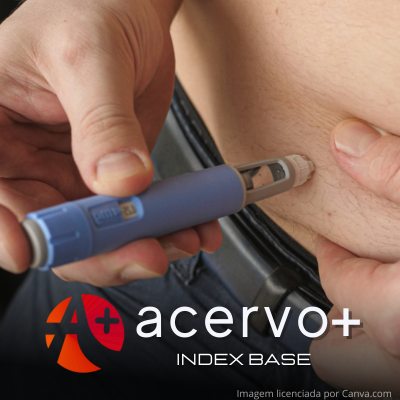Diabetes tipo 2: contexto fisiopatológico e atualização terapêutica com o uso da semaglutida
##plugins.themes.bootstrap3.article.main##
Resumo
Objetivo: Discutir o uso da semaglutida em pacientes com DM2, analisando o benefício de sua adesão terapêutica. Revisão bibliográfica: A alta incidência do diabetes mellitus do tipo 2 (DM2) alerta para a necessidade do desenvolvimento de terapias diversas, a exemplo da semaglutida, para o manejo clínico adequado a esses pacientes. O desenvolvimento do DM2 leva a uma disfunção metabólica, complicações microvasculares e macrovasculares. Neste contexto, evidencia-se o uso da semaglutida (por via oral ou subcutânea), um composto incretinomimético, com 94% de similaridade ao hormônio GLP-1. Mediante a testes clínicos realizados por diversos estudos, este fármaco apresentou resultados promissores levando a uma diminuição média de 0,9% da HbA1c, queda média de 4,3 kg, além de apresentar baixo risco hipoglicêmico e auxiliar no manejo do peso corporal. Considerações finais: Dado os riscos de complicações associados ao DM2 e a sua progressiva incidência populacional é de extrema relevância o conhecimento acerca do uso de semaglutida como alternativa de tratamentos com anti-hiperglicêmicos.
##plugins.themes.bootstrap3.article.details##
Copyright © | Todos os direitos reservados.
A revista detém os direitos autorais exclusivos de publicação deste artigo nos termos da lei 9610/98.
Reprodução parcial
É livre o uso de partes do texto, figuras e questionário do artigo, sendo obrigatória a citação dos autores e revista.
Reprodução total
É expressamente proibida, devendo ser autorizada pela revista.
Referências
2. de OLIVEIRA D, et al. Exercício físico e Diabetes mellitus TIPO 2. Universidade Federal de Ouro Preto (UFOP), 2011; 95-107.
3. FERNANDES NSM. Alterações metabólicas no diabético. Trabalho apresentado à Universidade Fernando Pessoa como requisito para obtenção do grau de Mestre em Ciências Farmacêuticas, 2013; 1-59.
4. FORBES JM e COOPER ME. Mechanisms of diabetic complications. Physiol Rev., 2013; 93(1): 137-88.
5. HANSEN BB, et al. Oral semaglutide versus injectable glucagon-like peptide-1 receptor agonists: a cost of control analysis. J Med Econ., 2020; 23(6): 650-658.
6. HEILE M, et al. Cardiovascular Outcomes with Once-Weekly GLP-1 RAs: Clinical and Economic Implications. J Manag Care Spec Pharm., 2018; 24(9-a Suppl): S42-S52.
7. JOHANSEN P, et al. Evaluating the Long-Term Cost-Effectiveness of Once-Weekly Semaglutide Versus Once-Daily Liraglutide for the Treatment of Type 2 Diabetes in the UK. Adv Ther., 2020; 37(5): 2427-2441.
8. KAKU K, et al. Safety and efficacy of once-weekly semaglutide vs additional oral antidiabetic drugs in Japanese people with inadequately controlled type 2 diabetes: A randomized trial. Diabetes Obes Metab., 2018; 20(5): 1202-1212.
9. LEITER LA, et al. The effect of glucagon-like peptide-1 receptor agonists liraglutide and semaglutide on cardiovascular and renal outcomes across baseline blood pressure categories: Analysis of the LEADER and SUSTAIN 6 trials. Diabetes Obes Metab., 2020; 22(9): 1690-1695.
10. MATZA LS, et al. Health state utilities associated with treatment process for oral and injectable GLP-1 receptor agonists for type 2 diabetes. Qual Life Res., 2021; 30(7): 2033-2043.
11. MINISTÉRIO DA SAÚDE. Diabetes Melittus. Caderno de Atenção Básica nº16. Brasília, Distrito Federal (2006), 56p.
12. NAUCK MA e QUAST DR. Cardiovascular Safety and Benefits of Semaglutide in Patients with Type 2 Diabetes: Findings from SUSTAIN 6 and PIONEER 6. Front Endocrinol (Lausanne), 2021; 12: 645566.
13. OVERGAARD RV, et al. Impact on HbA1c and body weight of switching from other GLP-1 receptor agonists to semaglutide: A model-based approach. Diabetes Obes Metab., 2019; 21(1): 43-51.
14. PRATLEY RE, et al. Oral Semaglutide Reduces HbA1c and Body Weight in Patients with Type 2 Diabetes Regardless of Background Glucose-Lowering Medication: PIONEER Subgroup Analyses. Diabetes Ther., 2021; 12(4): 1099-1116.
15. RODBARD HW, et al. Semaglutide Added to Basal Insulin in Type 2 Diabetes (SUSTAIN 5): A Randomized, Controlled Trial. J Clin Endocrinol Metab., 2018; 103(6): 2291-2301.
16. SCHNEIDER D, et al. The importance of patient-reported outcomes in type 2 diabetes: insight from the PIONEER program with oral semaglutide. Am J Manag Care, 2020; 26(16 Suppl): S356-S367.
17. SOCIEDADE BRASILEIRA DE DIABETES. Diretrizes Sociedade Brasileira de Diabetes 2019-2020. São Paulo: Editora Clannad; 2020; 455p.
18. SUMITA NM e ANDRIOLO A. Importância da hemoglobina glicada no controle do diabetes mellitus e na avaliação de risco das complicações crônicas. Jornal Brasileiro de Patologia e Medicina Laboratorial, 2008; 44(3): 169-174.
19. TAN X, et al. Efficacy and safety of once-weekly semaglutide for the treatment of type 2 diabetes. Expert Opin Investig Drugs, 2017; 26(9): 1083-1089.
20. YALE JF, et al. Use of once-weekly semaglutide in patients with type 2 diabetes in routine clinical practice: Results from the SURE Canada multicentre, prospective, observational study. Diabetes Obes Metab., 2021; 23(10): 2269-2278.
21. YAMADA Y, et al. Dose-response, efficacy, and safety of oral semaglutide monotherapy in Japanese patients with type 2 diabetes (PIONEER 9): a 52-week, phase 2/3a, randomised, controlled trial. Lancet Diabetes Endocrinol., 2020; 8(5): 377-391.
22. ZINMAN B, et al. Efficacy, Safety, and Tolerability of Oral Semaglutide Versus Placebo Added to Insulin with or Without Metformin in Patients with Type 2 Diabetes: The PIONEER 8 Trial. Diabetes Care, 2019; 42(12): 2262-2271.

